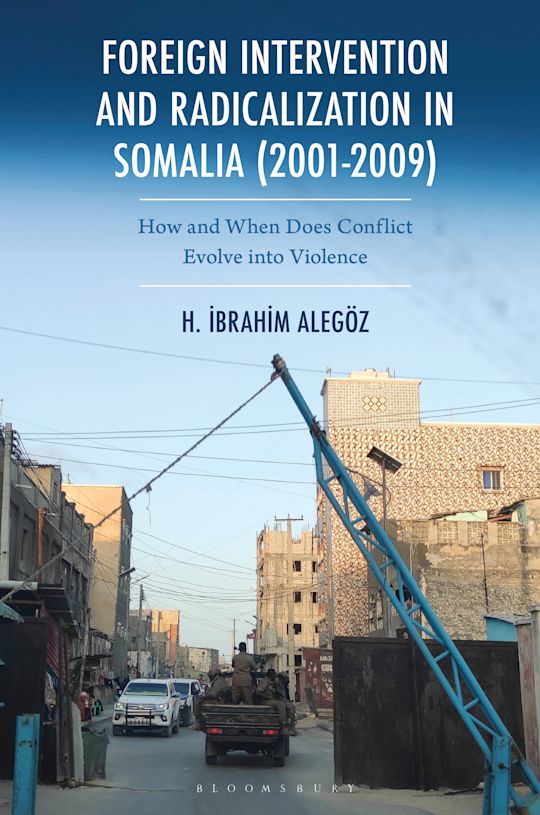- Home
- ACADEMIC
- African & Africana Studies
- Conflict and Peace in Africa
- Foreign Intervention and Radicalization in Somalia (2001-2009)
Foreign Intervention and Radicalization in Somalia (2001-2009)
How and When Does Conflict Evolve into Violence
Foreign Intervention and Radicalization in Somalia (2001-2009)
How and When Does Conflict Evolve into Violence
Payment for this pre-order will be taken when the item becomes available
- Delivery and returns info
-
Free UK delivery on orders £30 or over
You must sign in to add this item to your wishlist. Please sign in or create an account
Description
Foreign Intervention and Radicalization in Somalia: How and When Does Conflict Evolve into Violence (2001 -2009) analyzes political violence within a broader political context in which the mobilization of social movements takes place. The central focus of this book is to explain the social mechanisms through which the radicalization processes unfolded on the part of al-Shabaab between 2001 and 2009 in Somalia. H. Ibrahim Alegöz traces the intricate interactions of social mechanisms that gave rise to the steady escalation of more militant forms of conflict from a relational, dynamic, and process-oriented perspective.
The book offers an alternative approach to the existing models linking violence to ideological preferences, cultural templates, or ethnic and state-centric pathologies. Alegöz argues that historical and contentious political interactions play a crucial role in explaining violence. The author demonstrates how the interests of local, regional, and international actors have overlapped within the Global War on Terror framework. The book finds that radicalization dynamics have undergone two consecutive episodes of contentious social interactions that, at the onset, were related to the formation of the Mogadishu-based warlord alliance and escalated following the Ethiopian military intervention in Somalia. It prompted a power vacuum which allowed al-Shabaab to expand its tactical repertoire of action and modify its target preferences into a relatively institutionalized, aggressive, and clandestine character.
Table of Contents
Chapter I. Context and Theory
Literature and Research Design
Political Violence in Context: Relational Arenas of Interaction
Contentious Politics and the Relational Radicalization Framework
Chapter II. Somalia: A Decade of Political and Social Transformation
Civil War, Peace Operations, and Diplomatic Initiatives
Violent Entrepreneurs, Business Elites, and the Islamic Courts
Internalization of the Terrorism Paradigm in Somalia
Chapter III. Radicalization Trajectories of Al-Shabaab in Context
Navigating Local Threats: The Unification of Islamic Courts
The Global War on Terror and Local Alliance Formation
Ethiopian Military Intervention and the Rise of al-Shabaab
The Dynamics of Fragmentation in the Union of Islamic Courts
Chapter IV. Radicalization Mechanisms into Violence
Comparison through Mechanisms
Policy Implications
Conclusion
Product details

| Published | 19 Feb 2026 |
|---|---|
| Format | Hardback |
| Edition | 1st |
| Extent | 194 |
| ISBN | 9781666964851 |
| Imprint | Bloomsbury Academic |
| Illustrations | 10 b/w Figures (4 line drawings and 6 halftone) |
| Dimensions | 229 x 152 mm |
| Publisher | Bloomsbury Publishing |
About the contributors
Reviews
-
The dominant theories of social movement dynamics emerged out of the study of collective action in western democracies and it remains an open question as to whether those theories hold in other parts of the world and other regime contexts. That's what makes Alegoz' book so important. One could hardly imagine a political/cultural context more different than a western democracy than Somalia in the first decade of the new millennium. And yet Alegoz uses social movement theory to offer a compelling, nuanced, and convincing account of the radicalization of al-Shabaab between 2001 and 2009. An altogether welcome addition to the social movement literature.
Doug McAdam, Ray Lyman Wilbur Professor of Sociology, Stanford University, USA
-
To think that the emergence of al-Shabaab is simply a story of warlords emerging from political vacuum is to think way too narrowly. H. Ibrahim Alegöz demonstrates how to think broad-mindedly about this topic. The story he tells is rounded, examining not only the strategy of the militant group but also a range of forces at the local, national, regional, and international levels. But while rounded, this is not a story aimlessly rich in detail. It is rather a measured reconstruction of key dynamics by way of such mechanisms as outbidding and object shift, and such sub-mechanisms as threat attribution and brokerage. Foreign Intervention and Radicalization in Somalia (2001-2009) will benefit the discerning policy makers as well as the scholars of contentious politics, political violence, and terrorism.
Chares Demetriou, Lund University, Sweden


































